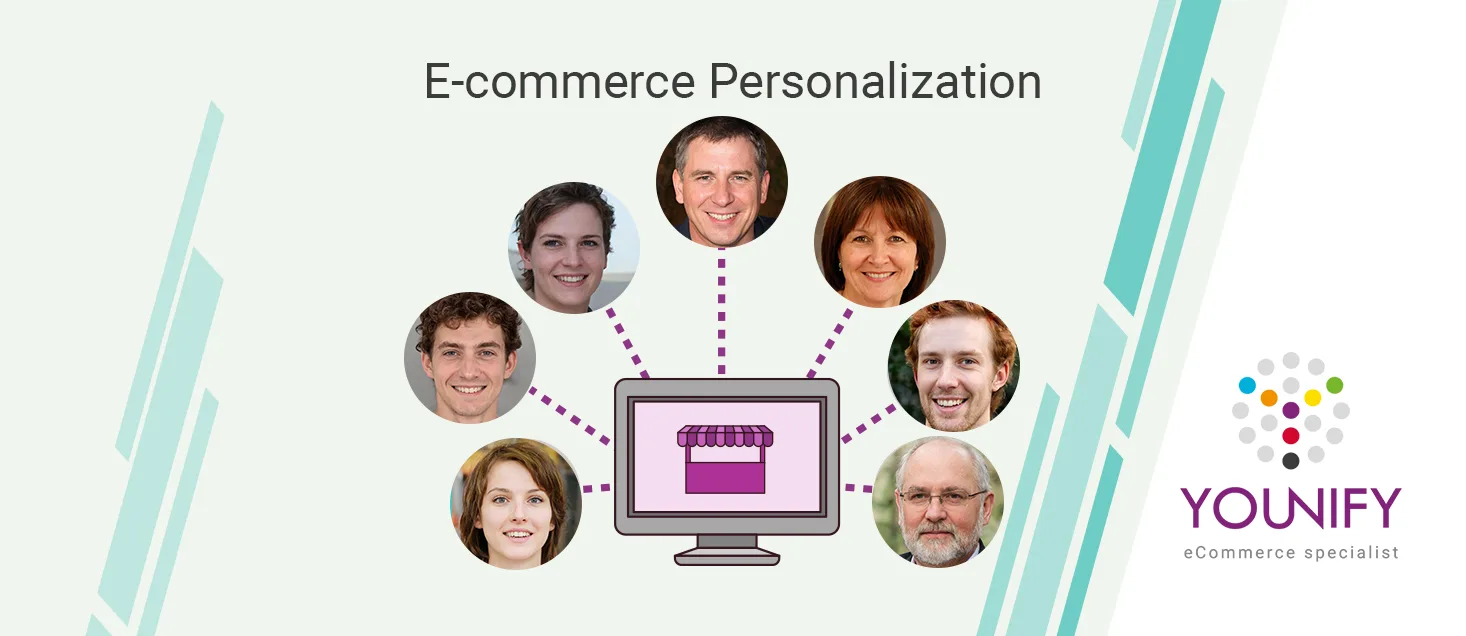First of all, what is E-commerce personalization?
E-commerce personalization is the practice of customizing the customer experience to the individual. This includes tailoring the website or app interface, product recommendations, marketing campaigns, and other interactions to the specific needs and preferences of each customer. Personalization can be based on a variety of data points, such as browsing and purchase history, demographics, location, and more.
The goal of E-commerce personalization is to create a more relevant and engaging experience for the customer. At the bottom of the funnel, this can lead to increased sales, higher customer retention, and greater brand loyalty. The simplest examples of E-commerce personalization include personalized product recommendations, personalized email campaigns, and personalized website content.
Benefits of personalization (Supported by Stats)
E-commerce personalization can provide several benefits, including:
- Increased conversions and sales: Personalized recommendations and targeted promotions can increase the likelihood that customers will make a purchase.
- Improved customer engagement: Personalized content and experiences can help to build trust and loyalty with customers.
- Increased customer lifetime value: Personalized experiences can lead to repeat customers who spend more over time.
- Better customer understanding: Personalization strategies can help E-commerce businesses to gain a deeper understanding of their customer’s preferences and behavior.
- Increased efficiency: Personalization can help to streamline the E-commerce experience for customers and make it easier for them to find the products they are looking for.
- Better customer experience: Personalization can make customers feel valued and understood, which can lead to better satisfaction and overall experience.
“Customers have high expectations for their favorite brands, and online marketplaces have never been more important,” she says. “Brands that are able to predict the desires of their online customers, and push relevant and inspirational content to them based on those desires, will see huge success in the coming years. Those who don’t will fall behind.”
Michelle Bacharach, the CEO and co-founder of AI-powered dynamic content creator FindMine
With that has been said by Michelle Bacharach, we want to emphasize one more time how much watching current trends is important for you and your business in order to stay relevant. To be on top of the game, you simply must know and apply the latest trends. We have a separate article about trends for 2023 and the years to come that you can check here.
Okay, but how to start E-commerce personalization?
Here are some steps to help you get started with E-commerce personalization:
Gather customer data
Before gathering any personal data, keep in mind that you should focus on building customer trust first. Sometimes personalization is best left to post-purchase, or at least once you have a relationship with customers. When consumers feel they can trust brands, they’re more likely to share their data. You can build trust by providing an awesome user experience and reliable support that’s available when customers need it.
When that step is complete, you then have several ways to gather customer data for further E-commerce personalization:
- Website tracking: Use tools such as Google Analytics to track customer behavior on your website, including pages visited, products viewed, and purchases made.
- Surveys and questionnaires: Use online surveys or in-person questionnaires to gather information about customer preferences and demographics.
- Email campaigns: Collect customer data through email campaigns, such as by including a sign-up form on your website or asking customers to update their preferences.
- Purchase data: Analyze purchase data to understand customer behavior, such as which products are most popular and when customers typically make purchases.
- CRM: Use customer relationship management (CRM) software to store and analyze customer data, such as contact information and purchase history.
By using these methods, you can gather a wide range of customer data that can be used to personalize your E-commerce website and marketing campaigns in the future.
Segment your audience
The next step would be to use the data you have collected to segment your audience into different groups based on characteristics such as demographics, purchase history, behavior, etc.
Create personalized content and offers
Use the segments you have created to create personalized content, offers, and recommendations for each group. Also test and optimize by incorporating A/B testing to see which personalized experiences are most effective, and make adjustments based on the results.
Incorporate personalization throughout the customer journey
Personalize not only the shopping experience but also the post-purchase experience, such as the confirmation email, shipping notification, and customer service interactions.
Keep track of your data
Continuously track and analyze customer data to make sure your personalization strategies are up-to-date and effective. You can do that by using a CRM (Customer Relationship Management) system to help you store and organize customer data, including contact information, purchase history, and browsing behavior.
Also, don’t forget to regularly review and update customer data to ensure that it is accurate and up-to-date, and use visualization tools to make it easy to understand and analyze that data.
By keeping track of your data and implementing the best practices, you can ensure the accuracy and integrity of your customer data, which will help you to deliver a better and more personalized experience for your customers for sure.
Now when we cover explaining how everything in theory works it’s time to go through some practical examples of personalization.
9 Examples of Ecommerce Personalization
1. Offer first-time visitors a special deal
We are big believers that first impressions are everything! On their first visit, you can entice your customers with a 10% discount, a one-time purchase, or a seasonal special offer tailored specifically to them. This way, you can introduce your customers to your brand and make it easier for them to decide to make a purchase.
2. Offer recommended searches to narrow down options
For large retailers with multiple departments and offerings, visitors can get overwhelmed if they don’t know where to start – especially if it’s their first time on the site.
Search recommendations can help narrow down a customer’s choices by suggesting searches based on the user’s data combined with other factors, such as data from previous first-time customers.
3. Show items that your customers like
As you begin to collect more data from repeat customers, machine learning can help suggest relevant items that match the customer’s tastes based on previous searches, clicks, and other site interactions. This type of personalization can make the user experience more enjoyable and easier for the customer while making them feel noticed by your brand.
4. Help them complete the collection or look
This type of personalization acts as a friendly salesperson, suggesting to the customer what goes with the product they’re considering. It helps the customer get a fuller picture of the product, how it could impact their life, and how other products could complete their purchase.
5. Suggest complementary products
Once the customer has landed on a product page or added something to their cart, complementary products are a great personalization strategy for upselling. They’re similar to suggesting items that go well with the product the customer is considering or buying, but instead of focusing on completing a look or collection, complementary products can help enhance the experience with the current product.
6. Suggest popular products
Placing popular items at the forefront not only helps orient customers when they come to your site but also serves as a form of social proof to eliminate uncertainty in the purchase decision based on what others are doing.
If a customer sees that a certain type of product is more popular than another, it’ll likely influence their decision and simplify their shopping experience. This is especially helpful for first-time customers who are likely to be comparing products from multiple sites. “Popular” items can be customized based on a cold-start user’s behavioral data or an authenticated customer’s habits or recent searches. This way, these items remain relevant to the category they’re shopping in.
7. Personalization of exit offers
When a visitor clicks the “Exit” or “Back” button without buying anything, exit offers can serve as a last-ditch effort to make a sale. These offers can sometimes seem desperate, so they should be positively worded and customer-focused to make them more effective.
8. Attract lost buyers
Most of us have seen a cart recovery email before, but the key to success is making it as easy as possible for customers to pick up where they left off shopping. A “return to cart” or “continue checkout” button minimizes the effort for customers to return directly to the cart and is more viable than a “continue shopping” prompt. Now, if you are the owner of a Magento 2 store and you want to make small tweaks like this, don’t hesitate to contact us. We will make that happen with ease.
9. Bring customers back with a special offer
This personalization tactic is based on a lack of interaction with a website and can help bring back customers who have turned away from a particular brand. This is often a worthwhile effort for companies, as attracting new customers can be more expensive than retaining old ones. Personalized email can help revive old customers definitely.
5 Tools for E-commerce Personalization (as we promised)
At the end of our article, we will give you a list of the best personalization tools that you can use (although there may be other tools that are better suited for your business in particular).
- Personalized Recommendations: tools such as Amazon Personalize and Recombee can be used to generate personalized product recommendations for customers.
- Email Marketing: tools like Klaviyo, Omnisend, and Mailchimp can be used to send personalized email campaigns to customers.
- Search and Navigation: tools like Algolia and Elasticsearch can be used to improve the search and navigation experience on your E-commerce site.
- A/B Testing: tools like Optimizely, VWO, and Google Optimize can be used to test different versions of your website to see which one performs best.
- Customer Segmentation: tools like Segment, Lytics, and BlueConic can be used to segment customers based on their behavior, demographics, and other data.
- Personalized Content: tools like Optimizely, Adobe Target, and Monetate can be used to deliver personalized content to customers based on their behaviour, demographics, and other data.
- Chatbot: tools like Tidio, Snatchbot, and ManyChat can be used to create a chatbot that can help personalize the customer experience by answering common questions and guiding customers through the buying process. We have a separate article about AI automatization tools that you can read here.
Ups, we included more than 7 tools. We hope that that isn’t a problem for you. Before using any of these tools, we highly recommend you research them first, so in that case, the excessive choice we have provided you with, won’t be such a problem.
Conclusion
In conclusion, E-commerce personalization is a powerful way to treat your customers like real stars and build long-lasting, loyal relationships with them. By using the tools that we mentioned, you can definitely provide a personalized shopping experience that will keep your customers coming back for more. Remember that the key to successful personalization is understanding your customers’ needs, preferences, and behaviour and using that information to create tailored experiences that will make them feel valued and appreciated. By implementing these strategies and using the best personalization tools, you can create a loyal customer base, increase conversions, and boost your revenue.





